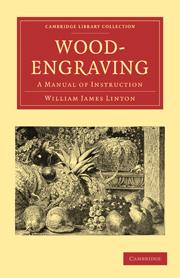Book contents
- Frontmatter
- PREFACE
- Contents
- ILLUSTRATIONS
- CHAPTER I Of engraving in relief
- CHAPTER II Of the history of Wood-Engraving
- CHAPTER III Of the difference between cutting and engraving
- CHAPTER IV Of the tools required for engraving on wood
- CHAPTER V Of drawing on wood for engraving
- CHAPTER VI Of the method of procedure in engraving
- CHAPTER VII Of things to be avoided
- CHAPTER VIII Of things to be aimed at
- CHAPTER IX Of beauty of line
- CHAPTER X Of the use and abuse of photography
- CHAPTER XI Of what constitutes an Artist
- CHAPTER XII of works for reference
- Index
- Plate section
CHAPTER VI - Of the method of procedure in engraving
Published online by Cambridge University Press: 29 August 2010
- Frontmatter
- PREFACE
- Contents
- ILLUSTRATIONS
- CHAPTER I Of engraving in relief
- CHAPTER II Of the history of Wood-Engraving
- CHAPTER III Of the difference between cutting and engraving
- CHAPTER IV Of the tools required for engraving on wood
- CHAPTER V Of drawing on wood for engraving
- CHAPTER VI Of the method of procedure in engraving
- CHAPTER VII Of things to be avoided
- CHAPTER VIII Of things to be aimed at
- CHAPTER IX Of beauty of line
- CHAPTER X Of the use and abuse of photography
- CHAPTER XI Of what constitutes an Artist
- CHAPTER XII of works for reference
- Index
- Plate section
Summary
HOW the engraver shall set about his work; what method to pursue from first to last; nay, first how to fit himself to become an engraver. A child may begin with carving his name, or by attempting to cut any few lines drawn for him on the block of wood. But a Manual is not intended for a child: rather is it for one too old or without opportunity to be under the supervision and continual instruction given to an apprentice. And to such an one, young man or woman, boy or girl, I would most distinctly and emphatically say: Do not begin with mechanism! Begin with a desire for art—to be an artist! Let no would-be engraver be content to become a mechanic! The days of mere mechanism in wood-cutting are numbered. Some one of the many processes for the reprodnction of fac-simile drawing will assuredly take the place of the work of the wood-cutter. Already, I think, fac-simile work is done better, and at less cost, without the intervention of the “engraver.” It is only the art, the artistic part of engraving, that is still worth our attention.
That artistic part is drawing with the graver. Learn, then, first to draw: to see form, and, after earnest endeavour, to be able to express it in the easiest way, by charcoal or chalk or pencil upon paper. It is much easier to learn to draw in this way than to learn to draw with the graver.
- Type
- Chapter
- Information
- Wood-EngravingA Manual of Instruction, pp. 52 - 66Publisher: Cambridge University PressPrint publication year: 2010First published in: 1884

